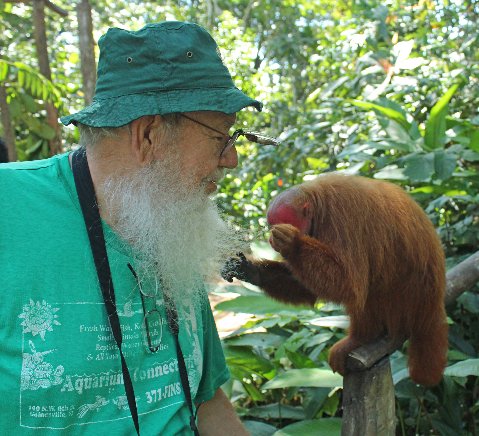Pierson, Kenny, and I had been out on Florida's western panhandle searching for brook, dusky, and dwarf salamanders. We had done okay and were now working our way back eastward stopping here and there to roll logs and dip our nets in whatever water was available.
We spent a lot of time sorting through aquatic vegetation, finding the tadpoles of various frogs, a few siren and amphiuma, a glossy crayfish snake or two, and in one net-full of vegetation, a neonate cottonmouth.

The finding of a cottonmouth in Florida is seldom worthy of comment for, although many snake species are somewhat harder to find than they once were, cottonmouths remain abundant.
When neonates, most are quite brilliantly colored in oranges, tans, and browns. But this baby, an intergrade between the eastern cottonmouth,
Agkistrodon p. piscivorous, and the Florida subspecies,
A. p. conanti, was clad in oranges that at some places bordered on red, bright tans, and deep browns, and was much prettier than most neonate cottonmouths.
In fact, I have not yet seen another that equals it.
Compare the bright colors of this neonate cottonmouth whith those of the more normally colored neonate, next.

This is a normally colored neonate cottonmouth.

 Author, photographer, and columnist Richard Bartlett is one of the most prolific writers on herpetological subjects in the 20th century. With hundreds of books and articles to their credit, Richard and his wife Pat have spent over four decades documenting reptiles both in the field and in captivity. For a list of their current titles, please visit their page in our bookstore. Author, photographer, and columnist Richard Bartlett is one of the most prolific writers on herpetological subjects in the 20th century. With hundreds of books and articles to their credit, Richard and his wife Pat have spent over four decades documenting reptiles both in the field and in captivity. For a list of their current titles, please visit their page in our bookstore. |




To prevent automated Bots from commentspamming, please enter the string you see in the image below in the appropriate input box. Your comment will only be submitted if the strings match. Please ensure that your browser supports and accepts cookies, or your comment cannot be verified correctly.